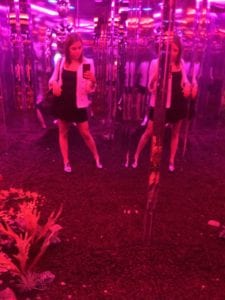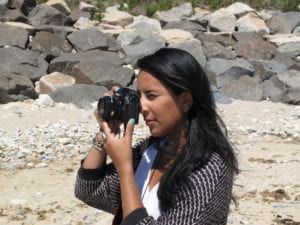Bronx-based Latinx artist Francisco Donoso is redefining borders and identity through his work.
Francisco Donoso‘s mixed-media practice might appear abstract at first, but his work is layered with the complexity of identity and politics. Working primarily with paint and found maps, Donoso investigates themes integral to the contemporary immigrant experience – one he is intimately familiar with as an Ecuadorean immigrant and DACA recipient.
Whatever the materiality his work manifests, Donoso values the creation “alter-mundos,” or “new worlds” in his paintings. Though his work is largely abstract, a recurring image that weaves its way into many of his paintings is the chain link fence.
Donoso’s impressive online presence as both artist and activist have landed him a spot on Domingo Comms’ roster of Featured Artists, highlighting works “from up-and-coming local New York, Latin American, and Latinx contemporary artists, conveying topical political statements in a colorful and impactful way.” Curated by Veronica Petty, the Domingo Comms’ Featured Artists program provides opportunity for young collectors to acquire works by living Latinx artists that inspire through their often radical messaging.
In our Q&A with Francisco, we discussed the immigrant experience, his studio home in the Bronx, and the importance of knowing your worth and value as an artist.

AZ: You create artwork that centers on the immigrant community, but also produce content dealing with the more recent immigrant experience (for instance, your video “On my way to the studio in the South Bronx.”) How does the Bronx community factor into the art you produce? Are there any arts organizations there that you are involved with?
Francisco Donoso: The Bronx has very quickly become a second home for me. There’s a no pretense- what you see is what you get and I love that. The Bronx is made up of generations of immigrants, it’s insanely diverse in every way- and it’s not only a major cultural center for NYC, but the birthplace of hip hop, racial justice uprisings and home to many artists, creatives and activists creating meaningful work in ways you don’t see anywhere else in the city.
As an immigrant from Ecuador that was raised in the Latinx hotspot of Miami, FL, The Bronx has felt like a haven. The energy of the Latinx people, the hustle, the appreciation for community and the unapologetic expression of culture inspires me.
It’s always felt important to me to connect with The Bronx in real and tangible ways. Years ago, I completed a Van Lier Fellowship in Visual Arts at Wave Hill – a garden and cultural center in The Bronx – an NYC hidden gem. Since then I’ve shown with The Bronx Art Space, a South Bronx community-run non-profit gallery, The Andrew Freedman Home, a historic arts site right across from The Bronx Museum, where I participated in the Artist in the Marketplace program in 2018 and look forward to showing at in 2022. More recently I’ve joined the BX200 artist community- an amazing listing of emerging and established artists in The Bronx, as well as The Bronx Council on the Arts. There is a bustling energy that comes from these arts institutions that move my practice forward.
I’ve been at my South Bronx studio almost 2 years now and I knew since the day I moved in that I wanted to use my studio as a way to support Bronx artists. My studio assistant is from The Bronx, and also undocumented. It’s a priority for me to invest in younger Bronx immigrant artists and use my studio as a site for teaching and learning as well as making.
AZ: You recently had a big learning opportunity when you turned down HBO Latino because of pay and timing disparities. How do you recommend other artists who may not have an established presence feel empowered to stand up for their worth? Particularly when it comes to opportunities that may give them a chance to reach their dream audience.
FD: Artists are indoctrinated to believe they are not in control of their own careers. We’re taught early on that unless others discover us and throw us a lifeline – that we are destined for obscurity – the myth of the starving artist. This leads to a scarcity mindset like no other! I want artists- young and old- to embrace their weird and take risks!
Knowing your worth is more than just a mathematical equation where you sum up time+materials+sales history. Your understanding of worth and your definition of success has to come from a place of abundance. That means trusting in yourself, your potential and the impact of your voice regardless of whatever opportunity comes your way. If it doesn’t serve you, don’t take it. I got more exposure for saying “no”, than I would have by accepting that opportunity. I learned that nothing good comes from a “desperate yes”, you can’t position yourself to grow when you don’t believe you deserve the best.
AZ: How does your status as a DACA recipient inform your activism with regards to uplifting Latinx voices in the art community?
FD: Having DACA means I have the opportunity to take bigger risks, for myself and on behalf of my family and my community. I know that trying to navigate life as a young emerging Latinx artist can be tricky, and much more when you’re undocumented – you feel completely erased and dislocated. I try to offer my community and other undocumented creatives opportunities I wish I had when I was younger.
For instance: last year I had the chance to co-organize an exhibition of my work and one other well-known artist, also a DACA recipient, in a large Upper East Side gallery – for free. We were inaugurating the gallery space and I wanted to make sure I was carving out a space for younger Latinx immigrant artists to be part of that event, so I curated a mini-show within my show, and included 3 younger immigrant artists, 2 of them also undocumented, so that they would experience the joys of exhibiting professionally and embodying the role of the working artist. Intentionally swinging the door open for each other is critical in shifting the landscape of the art world- we need more of us curating us, writing about us, selling us and advocating for us. It’s a huge privilege to have DACA- and I want to bring everyone I can with me on this ride.
AZ: How does your art seek to create space for immigrants who feel displaced culturally?
FD: My art is about the possibilities of existing outside of reinforced borders, national identities and limitations on our imaginaries-both self-imposed and those thrust upon us. Abstraction gives us the space to trespass those limitations and tap into our own sense of placement. We belong wherever we say we belong- because we own our narratives. Whether through painting, installation or interventions on maps, my work asks the viewer to examine their own subjective sense of belonging.
Immigrants often inhabit a liminal space that is part longing for a past life, and part desire for a new life. This fiercely powerful space removes us from the confines of the limiting belief that we can only exist in one way. Immigrants can exist in endless ways, and I hope my work can offer that.
Follow Francisco Donoso on Instagam to keep up with his latest work & activism.



